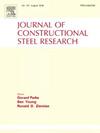Seismic performance evaluation of steel frame structures using self-centering prefabricated beam-column joints with weakened flange cover plates
IF 4
2区 工程技术
Q1 CONSTRUCTION & BUILDING TECHNOLOGY
引用次数: 0
Abstract
This paper continues the study of a novel self-centering prefabricated steel beam-column joint with weakened flange cover plates (WFCP-SCSJ). The seismic performance and the collapse performance of steel frames with WFCP-SCSJs (WSSF) were evaluated through numerical simulations. A six-story steel moment resisting frame was designed, considering various configurations and joint arrangements. Numerical models were established in OpenSees, and seismic time-history analyses and incremental dynamic analyses (IDAs) were carried out. Fragility curves were derived to assess the collapse resistance of different structural systems from a probabilistic standpoint. The results show that steel frames with WFCP-SCSJs exhibits superior seismic performance and self-centering capability, which meets the requirements in the Building Seismic Design Codes. Arranging WFCP-SCSJs on the inner side of the structural plane and along the weak axis effectively reduces the structural displacement response. Conversely, arranging WFCP-SCSJs solely on the first story of the structure leads to an abrupt change in structural stiffness and an increase in the displacement response. The failure probability of WSSF under different limit states is significantly lower than that of rigid-connected steel frames (RSF), and the collapse margin ratio (CMR) of WSSF is higher than that of RSF, indicating an excellent anti-collapse capability of the WSSF.
求助全文
约1分钟内获得全文
求助全文
来源期刊

Journal of Constructional Steel Research
工程技术-工程:土木
CiteScore
7.90
自引率
19.50%
发文量
550
审稿时长
46 days
期刊介绍:
The Journal of Constructional Steel Research provides an international forum for the presentation and discussion of the latest developments in structural steel research and their applications. It is aimed not only at researchers but also at those likely to be most affected by research results, i.e. designers and fabricators. Original papers of a high standard dealing with all aspects of steel research including theoretical and experimental research on elements, assemblages, connection and material properties are considered for publication.
 求助内容:
求助内容: 应助结果提醒方式:
应助结果提醒方式:


